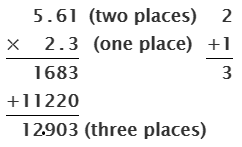
Multiplying Decimals
Concept
Multiplication of decimals is done by ignoring the decimal point and multiply the numbers, and then the number of decimal places in the product is equal to the total number of decimal places in both the given numbers.
Rules
Step 1: Initially, ignore the decimal point and multiply the two numbers normally.
Step 2: After multiplication, count the total number of decimal places in both the numbers. The product obtained after multiplication will have this total number of decimal places.
Step 3: Place the decimal point in the obtained product following Step 2.
Example
Austin bought 5.61 kg of candy for 2.30 dollars. How much did he spend altogether? Round your answer to the nearest hundredths.
Solution
Initially, ignore the decimal point and multiply the two numbers normally.

After multiplication, count the total number of decimal places in both the numbers. The product obtained after multiplication will have this total number of decimal places. Place the decimal point in the obtained product.

Austin spent $12.90 on candy.
Practice Multiplying Decimals

Product – Multiplying two whole numbers gives a product.
Factors – The numbers that we multiply are the factors of the product.
Multiplier – a quantity by which a given number (the multiplicand) is to be multiplied.
Multiplicand – a quantity which is to be multiplied by another (the multiplier).
Decimal number – a number whose whole number part and the fractional part is separated by a decimal point. The dot in a decimal number is called a decimal point. The digits following the decimal point show a value smaller than one.

